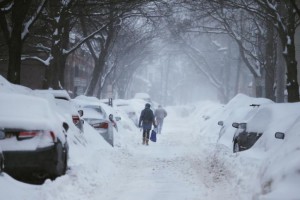A massive snowstorm that parked itself over the northeastern United States on Monday was forecast to drop up to two feet (60 cm) of snow over a region that has been repeatedly pounded over the past two weeks, closing schools and snarling travel.
Massachusetts Governor Charlie Baker asked residents to avoid traveling, Boston’s mass-transit system was operating on a limited scheduled and a majority of flights at Boston’s Logan International Airport had been canceled by early Monday morning.
But many commuters tried to carry on with their daily lives, unwilling to take what for some would be a sixth or seventh snow day of the winter.
“It’s irritating, but I’ve decided if I’m going to get to work, I have to deal with it,” said Gabby Whitaker, 24, as she waited for a bus to take her to her sales job near Boston. “I just have to get through it.”
The Massachusetts Bay Transportation Authority, whose aging trains have been hard-hit by the heavy snow and piercing cold over the past week, cut back service on Monday.
A train on the Red Line, Boston’s most heavily traveled rail line, got stuck on an above-ground section of track after snow covered the electric third rail. Some 48 passengers were evacuated, according to MBTA spokesman Joe Pesaturo.
The incident prompted MBTA officials to suspend service on that above-ground section of that line, and on some other ground-level sections of track.
“I am disappointed to hear that the MBTA and commuter rail are currently struggling to provide service due to weather conditions,” Baker said. “The MBTA’s condition and performance is concerning, reinforcing the need for riders to stay at home.”
Winter storm warnings were in place from central New York State, through northern Connecticut, Massachusetts and southern New Hampshire.
More than one foot (30 cm) of snow had fallen on Boston since the storm began early Sunday, according to the National Weather Service, which warned that the snow would likely continue into Tuesday morning.
As of 7 a.m. (1200 GMT) on Monday, Boston had received about 66 inches (1.7 meters) of snow this winter, putting the winter of 2015 on pace to stand among the 10 snowiest recorded winters in the city’s history, officials said.
“We don’t have that far to go to get into one of the top ten snowiest winters,” said NWS meteorologist Nicole Belk.
Boston received about 73 inches (1.9 meters) of snow in its 10th snowiest winter on record, the winter of 1919-1920. The all-time record seasonal snowfall, nearly 108 inches (2.7 meters) of snow, was set in the winter of 1995-1996, according to the NWS.
City officials have begun carting snow off of main streets bringing it to “snow farms” in south Boston, where specialized equipment melts 400 tons of snow per hour.
The heaviest accumulations came south of Boston, in North Weymouth and Norwell, which respectively reported 19.8 inches (50.3 centimeters) and 18.5 inches (47 centimeters) of snow.
Snowy conditions contributed to more than 1,800 flight cancellations around the United States on Monday, with the largest number of cancellations reported in Boston and at New York’s LaGuardia Airport.
The storm delayed proceedings in two major criminal trials, that of accused Boston Marathon bomber Dzhokhar Tsarnaev and the first murder trial of former New England Patriots star Aaron Hernandez.
A winter weather advisory was issued for the New York area, with 4 to 8 inches of snow (10 to 20 cm) and a quarter inch (0.6 cm) of ice possible through Tuesday morning.
“Does it drive me crazy? A bit, yeah,” said Deirdre Sheridan, 40, who works as a bartender in Boston as she smoked a cigarette in a doorway, out of the snow. “We should be used to it.”

